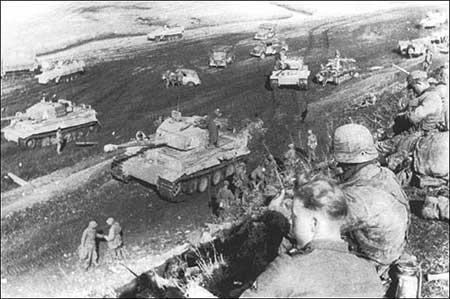The End of the Battle for the Ukraine

During the spring of 1944 the Red Army finally began wrapping up its enormously expensive eight month campaign to evict German forces from the Ukraine. The linchpin of this effort came against Army Group South's left wing - defended by its First and Fourth Panzer Armies. On March 4th Marshal of the Soviet Union Georgy Zhukov's 1st Ukrainian Front, spearheaded by the 3rd Guards Tank Army and 4th Tank Army, attacked German Army Group South's left wing. Zhukov's men forged numerous penetrations in German defensive lines already heavily weakened following the battle for the Korsun pocket. Zhukov's attack, though struggling at times against fierce German resistance, unhinged the German defensive front between the Fourth and First Panzer Army and penetrated deep into the German operational rear by flowing past the strongest part of the German defenses.
This massive offensive carried the Red Army across the pre-war Soviet border with Poland - where a brutal battle in and around the city of Tarnopol would play an important role in determining the complexion of the German Eastern Front entering a summer of 1944 that would decide the Third Reich's ultimate fate. Though Hitler declared Tarnopol a Fester Platz or "fortress" it was not a logical place for a defensive stand. Short of its importance as an important communications hub and minor industrial base, defending the city was made difficult in part because the surrounding terrain was largely flat and open. In addition, a further problem for the Germans was that the practical effect of Hitler's orders designating the city a Fester Platz was to further inhibit German mobility - the one thing allowing many German units to survive the Red Army's ability to penetrate the German lines nearly at will.
Nevertheless, in spite of the difficulty of their position Tarnopol's defenders had not only blocked Zhukov's initial attempt to take the city, but had launched aggressive counterattacks of their own. Nevertheless, Zhukov temporarily bypassed Tarnapol and his spearheads cut not only supply lines crucial to First Panzer Army's survival but also blew open a massive hole between First Panzer Army and Fourth Panzer Army to its north. Complicating the defensive task in the Fourth and First Panzer Army's sectors, beginning on March 5th Konev's 2nd Ukrainian Front, including the 5th Guards Tank Army and 2nd and 6th Tank Armies, also struck the overstretched German front and likewise leveraged First Panzer Army away from the Eighth Army to its south. While all this was going on the 3rd Ukrainian Front had pounded into the junction between the Eighth Army and Sixth Army further south yet - all developments auguring poorly for German chances to mass reserves needed to secure Tarnapol.
In and around Tarnopol, the German 359th Infantry Division and 69th Infantry Division temporarily stabilized the city defenses, as Soviet forces had first broken into the city on March 10th, but by March 12th-13th the 1st Ukrainian Front had enveloped the city and on March 24th completed the encirclement. An initial attempt by the 8th Panzer Division to cut through to the city failed the next day. In spite of the enormous pressure the Red Army brought to bear on the city its mixed bag of defenders held out. Finally, following another failed German relief effort, Soviet forces eradicated the pocket - mostly completing Tarnopol's capture by April 16, 1944.



Post new comment